When you think of traditional Russian cuisine, pelmeni might come to mind, but do you know its deep-rooted history and significance? Originating from Siberian indigenous tribes, pelmeni’s thin dough and minced meat filling were practical for nomadic lifestyles. As you explore its journey, you’ll find influences from the Mongol Empire and its role in Russian hospitality and community gatherings. Regional variations and modern gourmet twists have kept this dish relevant, symbolizing resilience and resourcefulness. Curious about how pelmeni connects to Russian folklore and celebrations? There’s much more to uncover.
Origins of Pelmeni
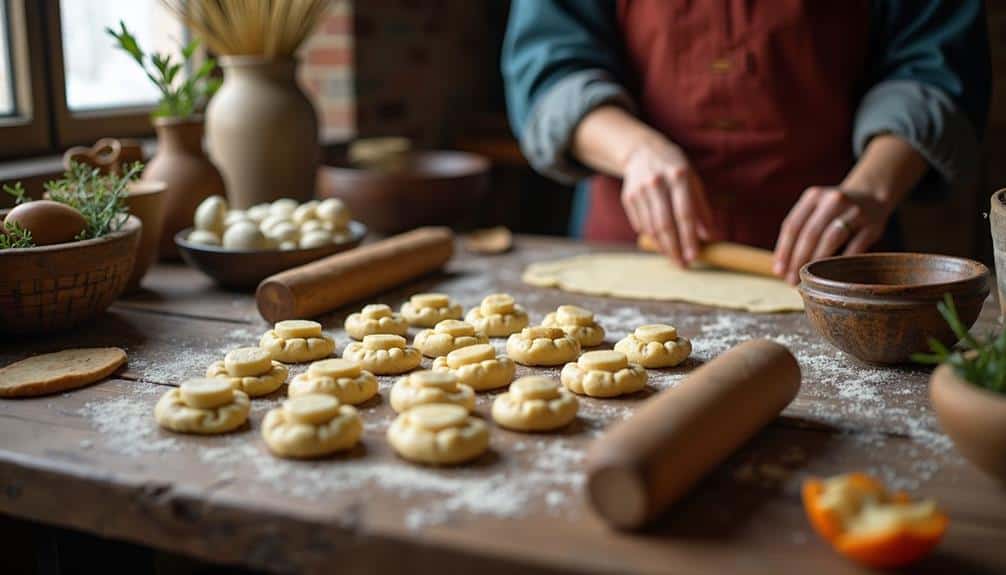
When delving into the origins of pelmeni, you’ll find a rich tapestry of history and cultural exchange. This beloved Russian dish traces its roots back to Siberian indigenous tribes, where practical needs shaped its creation. Historical influences from East Asia and the Ural regions also played a significant role. The Mongol Empire’s expansive reach facilitated the exchange of culinary techniques, blending elements from different cultures into what we recognize today as pelmeni.
You can see the historical influences in the dish’s basic structure. Traditional pelmeni consists of a simple dough filled with a mixture of minced meat, which reflects the nomadic lifestyle that favored easily preserved, protein-rich foods. This method of encasing meat in dough made it easier to transport and store during the harsh Siberian winters.
Culinary techniques have evolved, but the essence remains unchanged. The dough is rolled thin to guarantee quick cooking, a technique borrowed from Chinese dumplings. The filling, often seasoned with just salt and pepper, underscores a minimalist approach that highlights the quality of ingredients.
Grasping these historical influences and culinary techniques gives you deeper appreciation for pelmeni, beyond its delicious taste.
How To Make Pelmeni: Ingredients and Preparation
To truly appreciate pelmeni, you must start with its ingredients and preparation, which are straightforward yet integral to its flavor. The dough is a simple mix of flour, water, eggs, and a pinch of salt, creating a pliable texture suitable for wrapping. The filling traditionally consists of minced meat, often a blend of pork, beef, and sometimes lamb, seasoned with onions, garlic, salt, and pepper.
However, filling variations abound, reflecting regional preferences and available resources. You might find pelmeni filled with mushrooms, cabbage, or even fish in different parts of Russia. These variations offer a unique twist while maintaining the dish’s core essence.
Ingredients:
– 1lb ground beef or pork
– 1 onion
– 1/2 teaspoon salt
– 1/4 teaspoon pepper
– 2 cups all-purpose flour
– 1/2 cup water
– 1 egg
– Sour cream or butter, for serving
Preparation:
1. In a bowl, combine ground meat, finely chopped onion, salt, and pepper.
2. To make the dough, mix flour, water, and egg in another bowl until it forms a soft dough.
3. Roll out the dough on a floured surface and cut into small circles.
4. Place a small amount of the meat mixture onto each dough circle, then fold in half and pinch the edges to seal.
5. Bring a pot of salted water to a boil and cook the pelmeni until they float to the surface.
6. Serve hot with sour cream or melted butter.
When it comes to cooking methods, boiling is the most common. You drop the pelmeni into salted, boiling water and cook them until they float to the surface, indicating they’re done.
Some prefer to fry them after boiling for a crispy texture, or bake them in a rich broth for a heartier meal. Each method infuses the dumplings with distinct flavors and textures, enhancing their versatility.
Understanding these ingredients and preparation techniques deepens your appreciation for this beloved dish, connecting you to its cultural roots.
Pelmeni in Ancient Russia
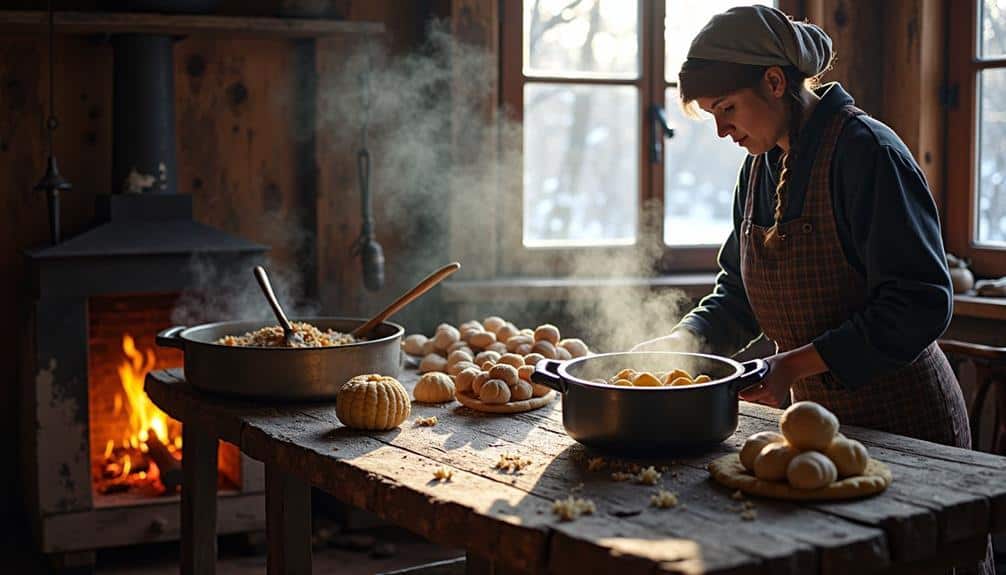
In ancient Russia, pelmeni were more than just a culinary delight; they were an essential part of survival and community. You’d find that pelmeni’s origins lie deep within the practices of nomadic tribes who roamed the vast, frigid landscapes. These tribes relied on ancient cooking techniques to prepare food that was both durable and nutritious.
Pelmeni, with their filling of minced meat encased in a thin dough, were perfect for sustaining energy during long journeys. You can imagine the communal aspect of making pelmeni, as families and tribes gathered together to prepare large batches before setting out on their travels. The process of making pelmeni wasn’t just practical; it was a social activity that reinforced bonds within the community.
Ancient cooking methods had to adapt to the harsh Russian winters. Pelmeni could be easily frozen and stored for months, making them an ideal food source during times when fresh ingredients were scarce. You’d appreciate how these dumplings were often cooked in boiling water or broth, providing warmth and sustenance in the coldest climates.
Fundamentally, pelmeni were a lifeline, embodying the resilience and ingenuity of ancient Russian culture.
Regional Variations
As the centuries rolled on from ancient Russia, pelmeni’s journey didn’t just stop at being a survival food; it evolved into a beloved culinary tradition with regional nuances.
In Siberian variations, the harsh climate called for robust, hearty fillings like mixed meats and spices, often frozen for long-term storage. You can trace Tatar influences in pelmeni to the addition of lamb and the use of spicier seasonings, enriching the dish with diverse flavors.
Ural recipes often include mushrooms and game meat, reflecting the area’s abundant forests.
Meanwhile, St. Petersburg styles lean towards a more refined approach, incorporating ingredients like veal and sometimes even caviar, echoing the city’s aristocratic heritage.
Far Eastern adaptations of pelmeni showcase a blend of Russian and Asian culinary traditions, often featuring seafood and unique dipping sauces.
Smoked pelmeni, a distinct variant, adds a rich, smoky flavor, popular in regions where smoking is a traditional preservation method.
Vegetarian options have also emerged, particularly in urban areas, with fillings such as cabbage, potatoes, and various herbs.
Regional fillings emphasize local ingredients and preferences, ensuring that each bite of pelmeni tells a story of its origin.
Pelmeni in Russian Folklore
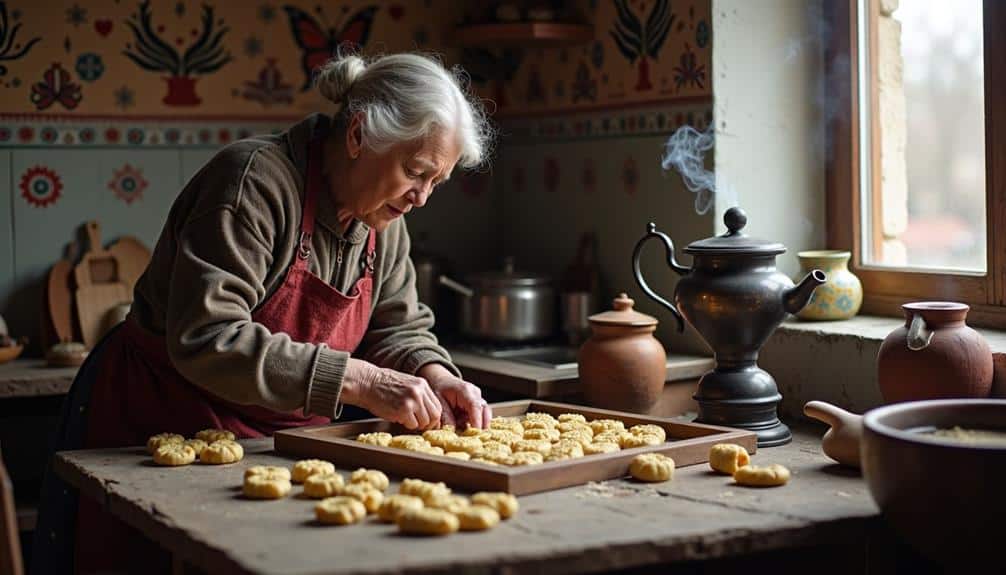
Folklore’s rich tapestry often weaves everyday elements into its narrative, and pelmeni holds a cherished spot in Russian legends and tales. You see, pelmeni isn’t just a dish; it’s a symbol deeply embedded in Russia’s cultural and culinary traditions.
In many Russian folk stories, pelmeni appears as a token of hospitality and community, reflecting an era when gathering to make these dumplings was a collective family affair.
Pelmeni carries folklore symbolism, representing warmth, sustenance, and togetherness. Imagine a snowy evening in a rural Russian village where families come together, hands busy crafting these delicate dumplings, sharing stories and laughter. This act of communal cooking not only nourished the body but also strengthened social bonds, a theme prevalent in Russian folklore.
Moreover, pelmeni often symbolizes resourcefulness and survival. Historically, they were made in large batches and stored for harsh winters, highlighting the ingenuity of Russian culinary traditions.
These tales remind you that food is more than sustenance; it’s a vessel of cultural identity and heritage. Through folklore, pelmeni transcends the kitchen, becoming a narrative thread that ties generations together, celebrating resilience and unity.
Soviet Era and Pelmeni
How did pelmeni navigate the complexities of the Soviet era? During this time, Soviet cuisine became a reflection of the state’s ideology, emphasizing simplicity, practicality, and uniformity. Pelmeni, with its straightforward ingredients and preparation, fit seamlessly into this culinary landscape. You’d find pelmeni not just as a meal, but as a symbol of resilience and adaptation.
The Soviet government prioritized foods that could be mass-produced and easily distributed, making pelmeni a staple in communal dining settings. Its compact size and high nutritional value made it ideal for feeding a large populace efficiently. For many Soviet families, pelmeni represented more than just nourishment; it carried a sense of cultural continuity amidst rapid social and economic changes.
In Soviet cuisine, pelmeni held a unique position. It was one of the few traditional dishes that managed to survive the regime’s push for modernization. The symbolism of pelmeni extended to its role in fostering a shared identity, providing comfort in uncertain times.
As you explore the Soviet era, you’ll see how pelmeni’s enduring presence in Soviet kitchens underscores its significance beyond mere sustenance, embodying resilience and cultural persistence.
Modern Pelmeni Trends
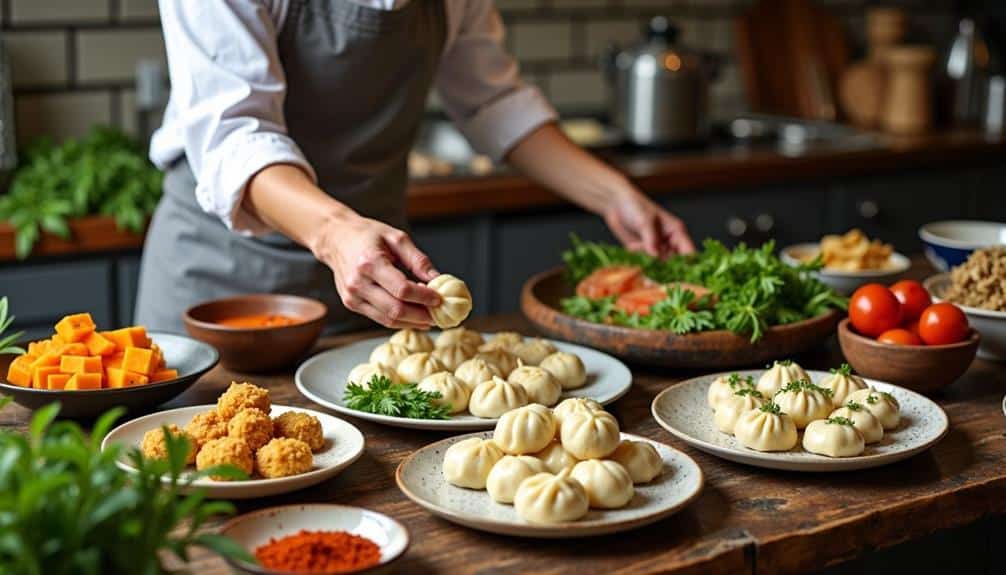
In today’s culinary landscape, pelmeni has experienced a renaissance, evolving in both preparation and presentation while retaining its cultural essence.
You’ll find that modern pelmeni trends have expanded beyond the traditional meat fillings, embracing gourmet pelmeni that feature luxurious ingredients like truffle oil, foie gras, and wild mushrooms. This evolution highlights a shift towards a more refined dining experience, catering to the sophisticated palate.
Contemporary chefs are also experimenting with fusion flavors, integrating elements from various cuisines.
Imagine pelmeni stuffed with spicy Thai basil chicken or creamy goat cheese and sun-dried tomatoes. These innovative fillings not only diversify the dish but also attract a global audience, enthusiastic to explore this Russian staple in a new light.
Restaurants are elevating pelmeni presentation, turning it into a visual masterpiece.
Think of pelmeni served with vibrant beetroot puree or garnished with edible flowers. This emphasis on aesthetics aligns with modern dining trends, where the visual appeal is as essential as taste.
Pelmeni in Russian Celebrations
Celebrating with pelmeni has long been a cherished tradition in Russian culture, weaving together the threads of family, festivity, and heritage. Whether you’re attending a wedding, a New Year’s Eve party, or a simple family gathering, pelmeni often take center stage. These delightful dumplings aren’t just food; they’re a symbol of unity and togetherness, crafted meticulously by multiple hands in a communal effort.
During festive occasions, the preparation of pelmeni becomes a shared activity, fostering bonds and creating memories. You might find yourself surrounded by relatives, each taking part in the process—rolling out dough, mixing fillings, and shaping the dumplings. This ritual underscores the importance of family gatherings, making the dish more than just a meal but an experience that ties generations together.
Pelmeni also serve as a reminder of cultural heritage. When you bite into one, you’re tasting a piece of history, a recipe passed down through countless generations.
At celebrations, the presence of pelmeni signifies respect for tradition and an appreciation for the past. So, the next time you find yourself at a festive occasion in Russia, pay close attention to the pelmeni—they’re not just food, but a living symbol of Russian cultural identity.
Health and Nutritional Aspects
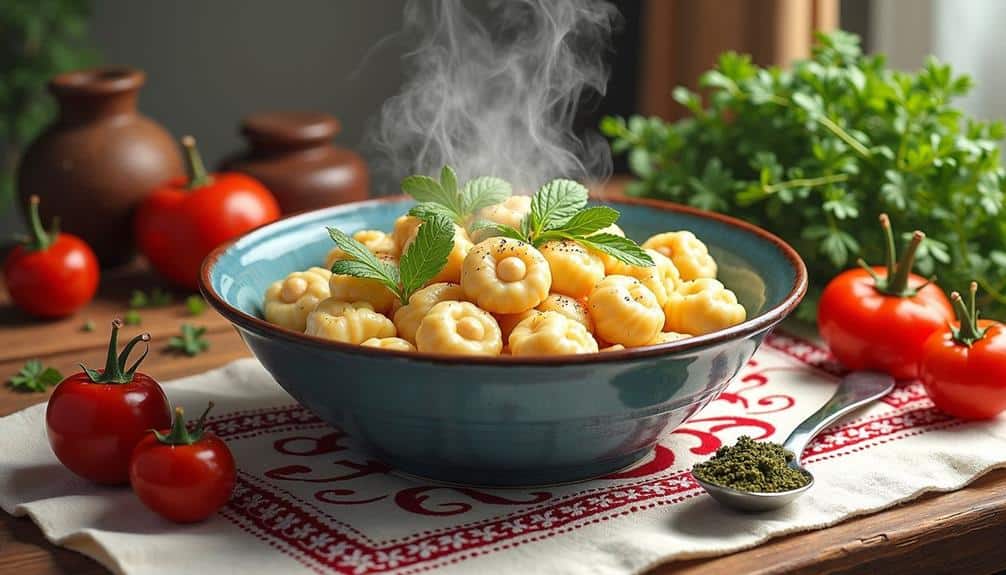
As you savor the rich flavors and history embedded in each pelmeni, it’s also worth considering the dish’s health and nutritional aspects. Pelmeni, typically filled with a mix of ground meat, onions, and spices, offer a balanced blend of macronutrients. The meat provides a good source of protein, essential for muscle repair and growth.
Additionally, the dough, often made from flour, eggs, and water, contributes carbohydrates, which are vital for energy. Analyzing the nutritional value, you’ll find that pelmeni can be a wholesome meal, especially when prepared with lean meats like chicken or turkey.
These meats not only reduce the fat content but also add valuable vitamins and minerals such as B vitamins and selenium. Including onions and spices in the filling enhances the dish’s antioxidant properties, contributing to overall health benefits.
However, it’s important to be mindful of portion sizes and preparation methods. Boiling pelmeni in broth instead of frying them can greatly cut down on added fats and calories.
Pairing pelmeni with vegetables or a light salad can also boost their nutritional profile, making this traditional dish not just a cultural delight, but also a health-conscious choice.
Pelmeni Around the World
Few culinary delights have managed to cross cultural boundaries as successfully as pelmeni. Originating from the Siberian region of Russia, these savory dumplings have found their way into kitchens and restaurants worldwide. Pelmeni globalization has introduced the dish to diverse palates, leading to fascinating variations and adaptations. From trendy New York eateries to cozy Parisian bistros, chefs have embraced pelmeni, experimenting with fillings and sauces that reflect local tastes.
You’ll find pelmeni festivals in cities like Moscow, Berlin, and San Francisco, where enthusiasts gather to celebrate this beloved dish. These events often feature cooking demonstrations, tastings, and even pelmeni-eating contests, showcasing the dish’s versatility and widespread appeal. The festivals have become cultural exchanges, where people from different backgrounds appreciate the artistry and tradition behind every bite.
Analyzing pelmeni’s global journey reveals how food can bridge cultures. As you savor a plate of pelmeni in a foreign land, you’re partaking in a shared human experience, where culinary traditions transcend borders.
The globalization of pelmeni underscores our collective desire to explore, understand, and enjoy the rich tapestry of world cuisines.
Conclusion
You’ve now explored the rich history and cultural significance of pelmeni, appreciating its origins, preparation, and enduring presence in Russian life. From ancient Siberian tribes to modern gourmet variations, pelmeni’s journey reflects resilience and adaptability. Whether enjoyed during festive gatherings or as a comforting meal, pelmeni symbolizes community and hospitality. Its diverse regional adaptations and global reach underscore its timeless appeal and nutritional versatility, ensuring that pelmeni remains a beloved dish worldwide.




